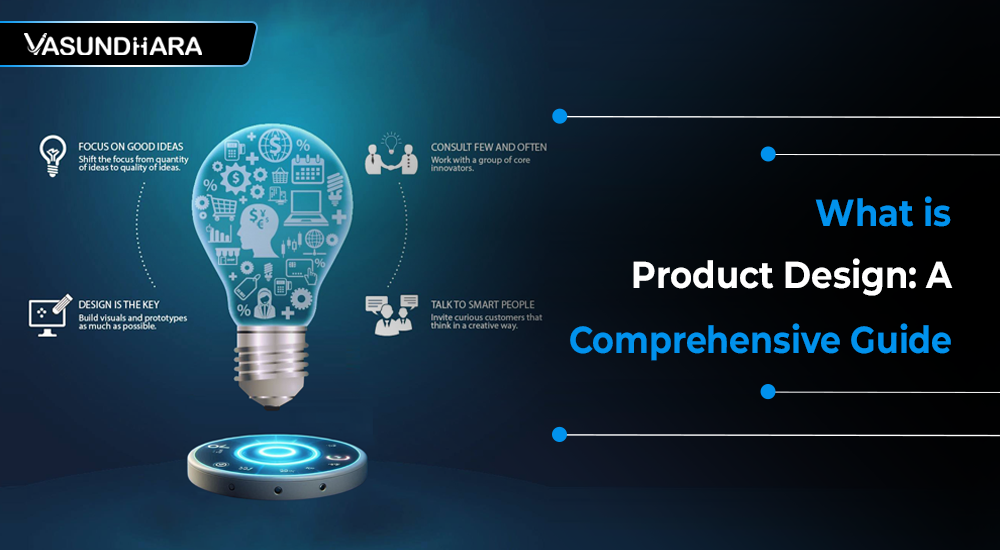What is Product Design: A Comprehensive Guide


- Feb 18, 2025



Product design is a multifaceted and dynamic process that involves creating and developing products that not only meet user needs but also stand out in the marketplace. It's a combination of art, science, and technology, with the ultimate goal of solving problems through creative, functional, and aesthetic solutions.
At Vasundhara Infotech, we specialize in delivering cutting-edge that blend innovation with user-centric design principles. Our team of expert designers and engineers ensures that every product is not only visually appealing but also highly functional and market-ready.
This comprehensive guide will explore the meaning of product design, its importance, the stages involved, key elements, types of product design, and the role it plays in the success of a product.
Product design refers to the process of conceptualizing, planning, creating, and refining products that meet the needs and expectations of users. It involves several considerations, including functionality, usability, aesthetics, market needs, and manufacturability. At its core, product design is about solving problems and creating solutions that bring value to users and stakeholders.
Unlike mere industrial design, which focuses mostly on form and function, product design incorporates a holistic approach that blends form, functionality, usability, and user experience (UX). This makes the process an essential part of the product development cycle.
Effective product design has a significant impact on the success of a product. It is not only about creating something that looks good but also about addressing user pain points and providing a meaningful experience. Here are some key reasons why product design is essential:
User-Centered Approach: Good design puts the user at the center. It focuses on understanding their needs, behaviors, and preferences. A well-designed product provides a seamless, intuitive, and engaging experience, leading to increased customer satisfaction.
Competitive Advantage: In a saturated market, products that are designed thoughtfully stand out from the competition. Unique design solutions can give a product a competitive edge and contribute to the success of the brand.
Increased Efficiency: Product design helps streamline production processes, ensuring that products are easier to manufacture, cost-effective, and sustainable. The process of designing also helps identify and reduce potential errors before they occur.
Brand Identity: A strong product design can contribute to the overall identity of a brand. It communicates the company’s values and the quality of the product. It is often the first thing that customers interact with, making it essential for brand recognition.
Business Growth: A well-designed product can lead to higher sales, better customer retention, and positive word-of-mouth referrals. It can also help reduce costs in the long run by identifying potential problems early in the design process.
Product design is a combination of various elements that together contribute to the success of the product. Here are the key components involved:
1. Functionality
The most essential aspect of product design is its functionality. It must work as intended and solve the user’s problem. Every design decision made during the process should be guided by the question: Does this feature make the product more useful?
2. Aesthetics
While functionality is paramount, aesthetics also plays a critical role. How a product looks influences a user’s perception of its quality and appeal. Aesthetics, including color, shape, texture, and form, help to communicate the personality and values of the product.
3. Usability
Usability is the ease with which a user can interact with the product. It encompasses how intuitive, accessible, and user-friendly the product is. This is where user experience (UX) and user interface (UI) design come into play, especially in digital products.
4. Ergonomics
Ergonomics involves designing products to fit the user’s body and the way they naturally interact with the environment. It focuses on making the product comfortable, efficient, and safe to use.
5. Sustainability
Today, sustainability is a key consideration in product design. Eco-friendly materials, energy efficiency, and reducing waste are critical components of sustainable design. Consumers are increasingly leaning toward brands that prioritize environmental impact.
6. Innovation
Innovative product design brings something new to the table. Whether it’s a unique feature, a new use for existing technology, or an entirely new concept, innovation is a driving force behind successful product design.
7. Cost-Effectiveness
While designing, cost considerations must be kept in mind. The design must be feasible within budget constraints and cost-efficient for mass production. This is an essential consideration for ensuring a product's profitability.
The product design process is broken down into several stages. Each phase is crucial in bringing an idea from concept to finished product. Below are the typical stages of the product design process:
The first step in product design is research. During this phase, designers gather insights about the target audience, competitors, market trends, and technological constraints.
They also identify the problem the product will solve and the needs it must address. User personas, surveys, and interviews are often used to understand the needs and pain points of users
Once the research phase is complete, the next step is brainstorming and generating ideas. In this stage, designers explore various concepts and approaches for solving the identified problems.
They create sketches, wireframes, mood boards, and prototypes to visualize their ideas.
In this phase, the ideas are refined and developed into concrete concepts. Designers narrow down their best solutions, taking into account factors such as feasibility, budget, and user preferences.
Mockups and digital prototypes are created to test and validate the design before moving on to the next phase.
Prototyping is the stage where designers create a physical or digital prototype of the product. This prototype is a functional version that allows designers and users to test and evaluate its performance.
The goal of prototyping is to identify flaws and make necessary adjustments before moving forward.
Testing involves putting the prototype through real-world situations to see how it performs. Feedback is collected from stakeholders and users to identify areas for improvement.
This phase might involve multiple iterations of the prototype to ensure the final product meets user expectations and performs efficiently.
Once the design has been tested and optimized, it’s time to finalize the design for production. The final design includes all necessary specifications, such as materials, dimensions, colors, and other technical details. It also includes any required documentation and instructions for manufacturing.
In this stage, the product is mass-produced, and the marketing and distribution strategies are put in place. The product is launched into the market, and feedback is continuously gathered to monitor its performance.
There are various types of product design, each focusing on different aspects of the product. Here are the main types:
Industrial Design: This is the most common form of product design and focuses on creating products that are both functional and aesthetically appealing for mass production. Examples include household appliances, vehicles, and electronics.
Interaction Design (IxD): Interaction design focuses on the way users interact with a product, especially in the context of digital interfaces. It is concerned with the structure, behavior, and responses of a system.
UX/UI Design: UX (User Experience) and UI (User Interface) design are critical for digital products such as websites, apps, and software. UX design involves the overall experience, while UI design focuses on the look and feel of the product.
Service Design: Service design is the process of designing services that deliver an excellent customer experience. It involves creating systems, processes, and touchpoints that ensure a seamless interaction between the service and its customers.
Sustainable Design: Sustainable product design focuses on creating products with minimal environmental impact. This includes using eco-friendly materials, reducing energy consumption, and ensuring the product is recyclable.
A product designer is responsible for overseeing the entire product design process, from the initial research phase to the final product launch. They work closely with other stakeholders, such as engineers, marketers, and manufacturers, to ensure that the product meets both user and business needs.
A product designer needs to have a diverse skill set, including creativity, problem-solving, technical knowledge, and communication skills.
To excel in product design, a designer must possess the following skills:
Creativity: The ability to generate innovative ideas and come up with unique solutions to problems.
User-Centered Design: Understanding the user’s needs, behaviors, and pain points is essential to creating functional products.
Prototyping and CAD Skills: Familiarity with prototyping tools and computer-aided design (CAD) software is essential for creating accurate models.
Problem-Solving: Product designers must be skilled at identifying problems and coming up with practical solutions.
Collaboration: Product designers often work in multidisciplinary teams, so the ability to collaborate effectively is crucial.
Product design is a critical component of the product development cycle, requiring a blend of creativity, technical knowledge, and a deep understanding of the target market. Whether you are designing a physical product, a digital interface, or a service, the product design process is essential to creating something that resonates with users, stands out in the market, and solves real-world problems.
Ready to Turn Your Ideas into Exceptional Products?
Whether you're launching a new product or refining an existing one, our expert product design services can help you create innovative, user-centric solutions that stand out in the market.
Contact us today to get started on transforming your vision into reality!
Copyright © 2025 Vasundhara Infotech. All Rights Reserved.